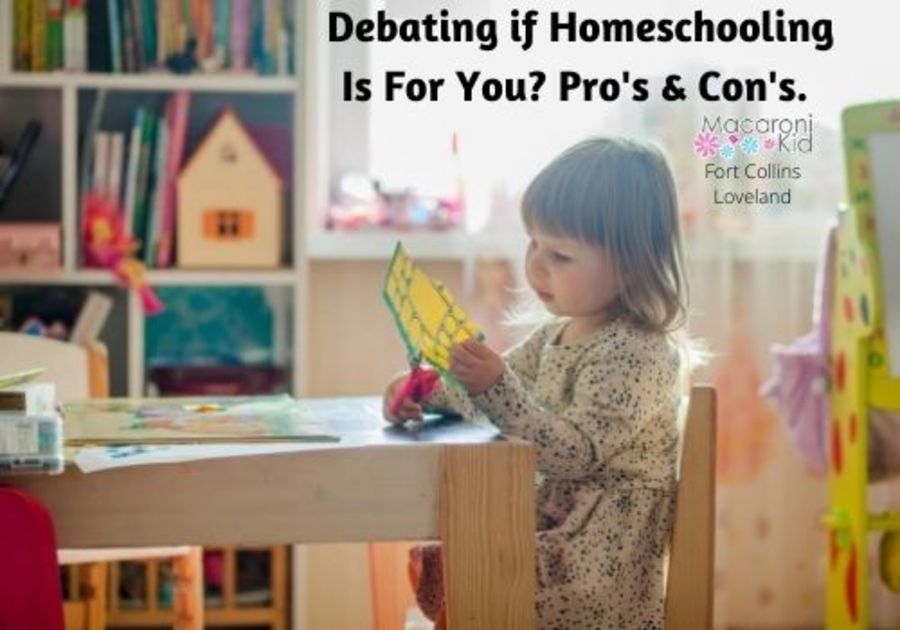After going through what was an interesting end to the school year to say the least.
I decided to reach out to some local Homeschool groups and teachers.
We have some incredibly wonderful teachers, great schools but the uncertainty of last spring was more than many parents and kids could handle. Us included. We love our school, staff, and teachers but with that in mind and the new ever-changing guidelines we made the choice to investigate what homeschooling had to offer.
After having many in-depth discussions with current homeschool families, I've created some pro's and con's with their help.
My dad used to deliver all news like this “Do you want the good or the bad first?” I always asked for the bad. So, we will start there.
Let’s start with the bad...
Choices:
They all said there are so many choices that it can be daunting. You can do paid, free, and a mix of both. There are courses that are fully laid out and there some that you can pick and choose to make your own individualized curriculum. Again, it's flexible and that can be both good and bad.
Cost
You are in charge for all financial needs from textbooks to individual courses or complete curriculum. Everything including tours to field trips etc.
You can find sales on back to school items and essentials and leave other things behind that aren't needed or not needed in large quantities like you would purchase for returning to public school. As far as courses you can find free materials and courses too.
If you order complete brand new curriculum packages from it could also be as costly. Especially with more than one child at home. Most of the parents I spoke with are a mix of both (Eclectic homeschooling).
Time
It's going to take time that many parents don't have. Working parents may have a rough time dedicating time when they already have a full plate. You can designate another family member to assist with schooling which can help. On the upside, every parent I talked to said that the homeschool day is shorter than the public-school day. Only on occasion does it take more than 4 hours for the majority of families I spoke with.
Socialization
It's the first question every parent asks before they consider homeschooling. How will I socialize my child?
The veteran homeschoolers I've talked to have said that many new opportunities have recently opened up such as Zoom Classes made available to all kids since the pandemic.
Sports and other extracurricular activities are available for homeschoolers too. Public schools have options for homeschoolers in these areas.
Now for the good news...
Flexibility
You can make the day unique to you and your child. What works for your family and it doesn't have to look like a typical school day. It can if that works for you but if not - don't worry. Don't feel that you must adhere to what the public-school day usually looks like if something else works better for your family. If mornings work for you, do mornings. If afternoon or evening work. Do afternoon or evening.
You can teach and the kids can learn at a formal desk set up or at the kitchen table. They can learn in a museum, in the back yard or online.
You can dress up, dress comfortable, or stay in your jammies. Though I'd suggest clothes to make the day seem focused.
All you need to do is adhere to the Colorado laws stating that an average of 4 hours a day are dedicated to teaching over a minimum of 172 days of instruction in Colorado .
A couple more things to consider are Teaching style and Learning style.
Learning Style
Each kid is an individual and they have their own learning style. This is a perk of Homeschooling. You can teach the way your child learns.
What’s your child’s leaning style?
Information from Diana Waring https://www.youtube.com/watch?v=6mRYjR79sHA
Feeler - Loves people, field trips, discussions, interacting, is a talker and will be asking tons of questions.
Thinker - Loves Planned day schedule, orderly events, Loves when things go as planned, follows instruction easily, creates their own structure
Sensor - Love to move and do hands on, bounces around, seems uncontrollable but loves interactive engagement.
Intuitor - Daydreamer, creative, they will be imaginative and will bring up things in that are unexpected.
Homeschool On has a fun quiz that determines if you kid learns in a kinesthetic, auditory, or a visual style.
Teaching style
Information from Diana Waring https://www.youtube.com/watch?v=cTwcKDlEv4s
There a few things to know before teaching, is your teaching style. Keep in mind your teaching style may not match your child's learning style. That's ok. Knowing the differences and similarities will help you both get along together better and will enhance your relationship in the long run.
Feeler - interpersonal relationships withing the home and family are key, you want to explain so everyone understands what they are doing and why they are doing it.
Thinker - you thrive on order, schedules, no interruptions. Lesson plans set and ready. Items for your lessons are set out and ready for the next day.
Sensor - Hands on, experiments, crafts, models, teach hands on.
Intuitor - Tons of ideas on how to teach, comes up with your own curriculum, love interruptions and going on tangents related to subjects to investigate and teach Loves to surprise with an adventure.
Styles of Homeschooling
Schooling at Home is basically the same as your local public or private school classroom, but it’s implemented at home. Typically organized around complete curriculum packages, arranged by school year, and might even be the same curriculum your local public or private school uses. School-at-Home education can be done independently or by online schools.
Unschooling is where your child explores a topic until they are satisfied. Learning plans and study projects are created largely on the student’s interests and explored in learn as you go activities and experiments. Basic skills like reading, writing, and arithmetic, done through technology.
Montessori focus on guided exploration. Kids explore what they are interested in. Discovering the world around them. They use some
Classical is guided by an "Applied Trivium" framework. Structured historical curriculum that cycles around every 4 years in chronological order. Subjects are interwoven throughout.
Charlotte Mason Method incorporates short periods of study with nature walks, nature journals, history portfolios, observation, memorization, and narration. Reading includes biographies, classics, and stories of heros, and life lessons. Lessons are somewhat child guided fairly flexible.
Eclectic is also referred to as "Relaxed" homeschooling. Parents use different methodologies mixed together and focus on a child's unique learning style per subject not homeschool style. Eclectic is mostly child-directed, resourceful, and non-curriculum based. Lesson plans are a sampling from any combination of homeschooling methods, or resources.
If you've decided on homeschooling
these are some simple steps to get you on your way.
Step 1: Know your state laws. Colorado Department of Education has the steps spelled out pretty well. https://www.cde.state.co.us/choice/homeschool.
Step 2: LOI/NOI. You must notify the state of your intent to homeschool with a Letter/Notice of Intent referred to as a NOI or LOI. This can be mailed to any school district in the state, not just your home district. Find out more in "So, You're Thinking Home School? Here's The Rules In A Nutshell." I have links to sample Letter/Notice of Intent as well as where to send your LOI/NOI.
Step 3: Deschool. From speaking to homeschool moms who have made the transition it is suggested to do a period to “deschool.” Most suggest a month but you can take as long as you feel you need. It really depends on your child and ho long it takes to decompress and ease into the idea. Deschooling is the period used to establish your own daily routine, organize a schedule, figure out your child's learning style and your teaching style and to follow their lead before choosing a curriculum.
Step 4: Choose your curriculum. This is overwhelming. Many parents go into this thinking they have an idea of what they want only to find out there are so many ways to accomplish what they want. Make sure you consider your teaching style, your child's learning style and your lifestyle.
You can homeschool in a way that fits your family. If you are looking for local support, I would suggest Facebook groups. I have found a bunch of great supportive homeschool moms on various sites. You can find a couple of favorites of mine in "So, You're Thinking Home School? Here's The Rules In A Nutshell." or by searching Homeschool.
 |  |  |  |



